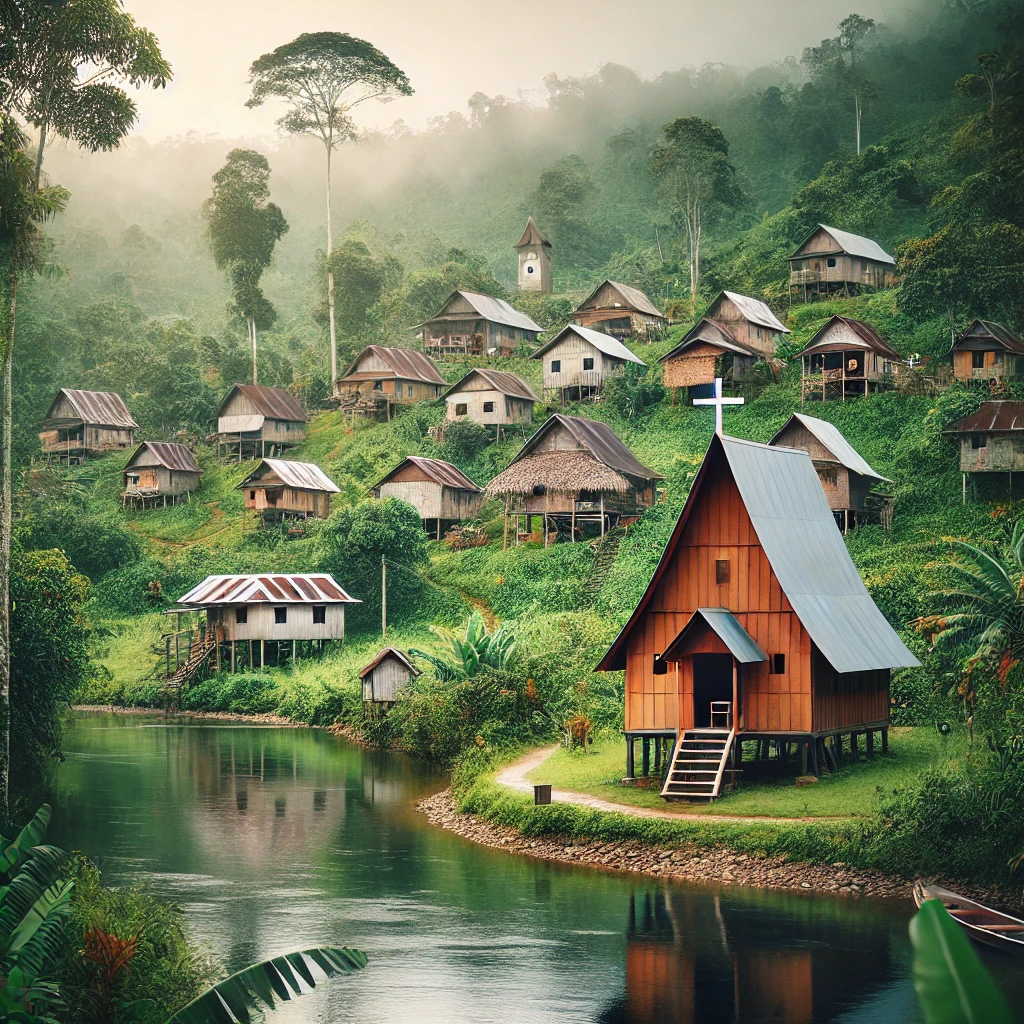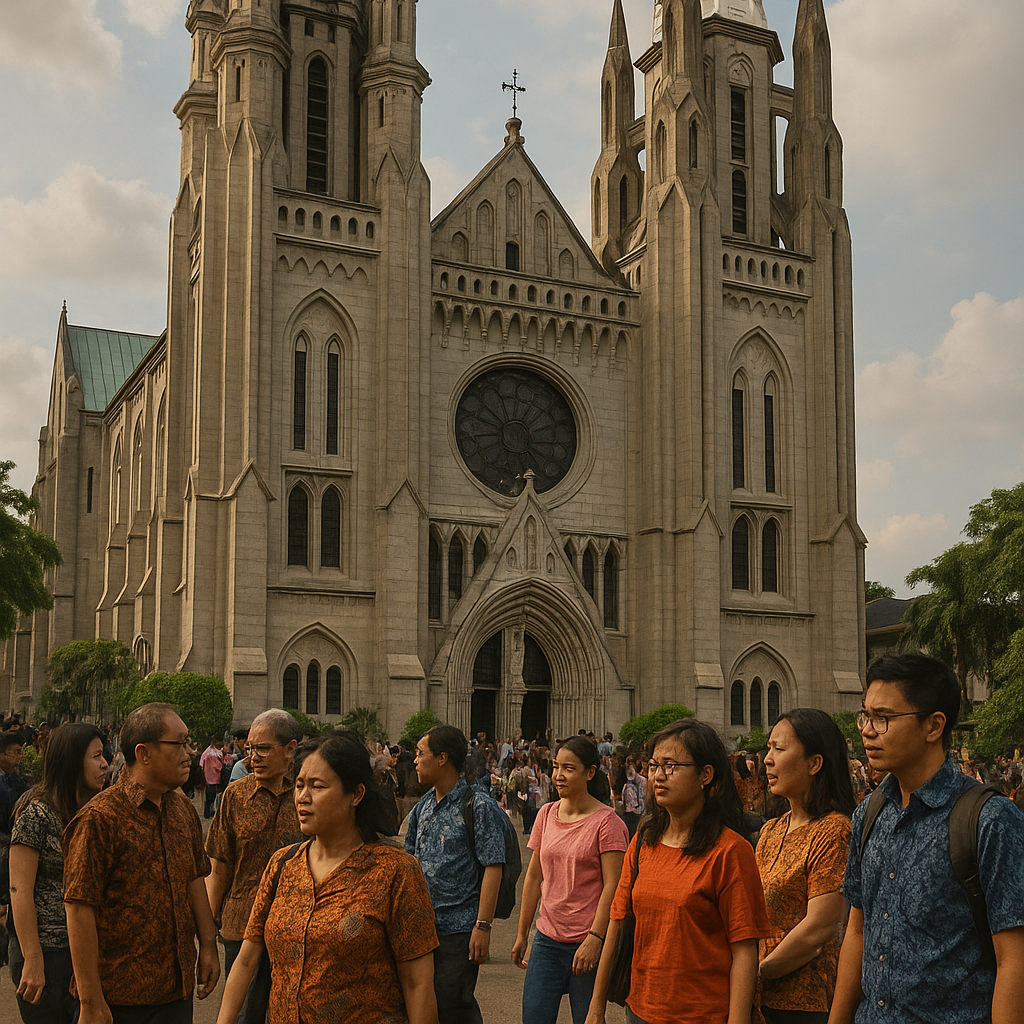From Mission to Congregation: The History of the Spread of Christianity in Bulungan, North Kalimantan
theolingua.id – Bulungan Regency is a region in North Kalimantan Province with an area of approximately 13,182 km². Located in the northern part of Borneo Island, this region directly borders Malinau Regency in the west, Tana Tidung Regency in the south, and has access to the Sulawesi Sea in the east. Geographically, Bulungan consists of coastal and inland areas, with ecosystems rich in tropical rainforests and large rivers, such as the Kayan River, which is the main transportation route for the local community.
Demographically, Bulungan’s population consists of various ethnic groups, including the Dayak, Tidung, and Bulungan tribes, as well as immigrant communities such as the Javanese, Bugis, and Banjar. This ethnic diversity also reflects the religious plurality in this area, with Islam as the majority religion, followed by Christianity, Catholicism, Hinduism, Buddhism, and local beliefs.
Culturally, the Bulungan people have a strong traditional heritage, especially in terms of art, traditional rituals, and a social system that still upholds local values. In a religious context, customs often interact with the religious teachings embraced by the community, creating a unique pattern of acculturation, including in the development of Christianity in this region.
The study of the journey of Christianity in Bulungan is of great urgency in understanding the history of the spread of religion in North Kalimantan. Although Christianity has been present in this area since the missionary and colonial eras, there are still limitations in the systematic documentation of how this religion has developed over time, as well as how the local community has responded to its presence.
In addition, this kind of research will be very important given the role of Christianity in shaping social dynamics in Bulungan. The church not only functions as a place of worship, but also as a centre for education and social activities that have an impact on people’s lives. The challenges faced, such as regional accessibility, interaction with local beliefs, and government policies related to religion, are interesting aspects to be studied in more depth.
In the midst of modernisation and social change, understanding the development of Christianity in Bulungan is also important to see how the church and the Christian community adapt to the dynamics of the times. With this kind of research, it is hoped that a clearer picture can be obtained of how Christianity has developed, survived, and contributed to the life of the Bulungan community historically and contemporarily.
History of the Entry of Christianity in Bulungan
The entry of Christianity in Bulungan Regency, North Kalimantan, is part of the process of religious diffusion that has occurred in Indonesia since the colonial era. Religious diffusion itself refers to the spread of religious beliefs and practices from one region to another through various mechanisms, including migration, trade, religious missions, and cultural interaction. In the Bulungan context, the spread of Christianity can be explained through the theory of diffusion of expansion and the theory of diffusion of relocation, which illustrates how this religion was introduced, developed, and has survived to this day.
Christianisation in Bulungan began with the arrival of Christian missionaries who brought religious teachings from outside Kalimantan. In the late 19th to early 20th centuries, evangelism in Kalimantan began to receive attention from mission organisations, both European and domestic. Missionaries from Protestant and Catholic churches began to enter the interior regions of Kalimantan, including Bulungan, with the aim of introducing Christianity to the local community, especially to Dayak tribes who still adhered to animistic beliefs.
The missionaries who played a role in the spread of Christianity in this region not only brought religious teachings, but also introduced education and health services. This approach is an important strategy in the theory of religious diffusion, where religion often spreads through integration with aspects of people’s social life. In the case of Bulungan, the presence of missionaries was also aided by trade routes and political relations with the Dutch colonialists, which provided access for religious propagation activities.
After the initial stages of missionary dissemination, Christianity began to develop through diffusion of expansion, which is when local people who had accepted the religion began to spread it to their own communities. This process was supported by the construction of the first churches in Bulungan, which functioned not only as places of worship but also as centres for religious and social education.
Another factor that accelerated the growth of Christianity in Bulungan was the migration of people from other parts of Indonesia. In the mid-20th century, the Indonesian government began to open a transmigration programme that brought people from Java, Sulawesi and East Nusa Tenggara to North Kalimantan, including Bulungan. Many of these transmigrants were Christians, so their presence helped strengthen the existence of the Christian community in this area.
As in many cases of the spread of religion in the archipelago, the entry of Christianity in Bulungan was not without challenges and resistance from the local community. Ancestral beliefs in animism and traditional customs that have long been rooted in the local community have caused some groups to reject this new teaching. In addition, interaction with Islam, which is the majority religion in the coastal region of Bulungan, has also been a factor influencing the dynamics of the spread of Christianity.
In facing this challenge, the church in Bulungan has adopted an approach of inculturation, which involves adapting Christian teachings to the local culture so that they are more easily accepted by the community. Examples include the use of the local language in services and the church’s efforts to support social activities that are in line with local cultural values. This approach is part of the theory of religious diffusion which emphasises that the spread of religion depends not only on the transmission of doctrine, but also on the ability of the religion to adapt to new social and cultural environments.
Today, Christianity in Bulungan has become an integral part of the social life of the community, especially in the Dayak community and transmigrant groups. Local churches continue to grow, with various denominations such as Catholic, Protestant, and Pentecostal having active congregations. Apart from being a place of worship, the church also plays a role in education and social affairs, such as establishing Christian schools and being involved in community welfare programmes.
The process of religious diffusion that occurred in Bulungan shows that the spread of Christianity was not only the result of a religious mission, but also involved social, economic, and cultural factors. By understanding the history of the entry of Christianity through the perspective of the theory of religious diffusion, it can be seen how this religion developed through various stages and adapted to the dynamics of the local community.
Development and Challenges of the Christian Community in Bulungan
Over time, the Christian community in Bulungan, North Kalimantan, has undergone various developments influenced by social, political, and cultural factors. This process not only reflects the internal dynamics of the Christian community, but also how they interact with the local culture and other religions that have long existed in the region. In understanding this development, the theory of acculturation and the interaction of religion with culture provide a relevant framework for analysing how Christianity has adapted to its social environment and the challenges it has faced over time.
In the early stages of the spread of Christianity in Bulungan, the Christian community faced challenges in adapting to long-established local cultures. Most of the indigenous peoples, especially the Dayak tribe and the Muslim-majority coastal communities, had strong traditions of belief and customary practices.
In the context of acculturation theory, the spread of Christianity in Bulungan did not happen instantly, but through a process of selective assimilation in which elements of the local culture were retained despite the transition to Christianity. This acculturation made Christianity more accepted, while creating harmony between the new belief and the existing culture.
During the Dutch colonial era, Christianity began to spread more widely as missionary activity increased and colonial government policies provided support for Christian-based schools. However, in the process, the Christian community also faced challenges from the more dominant presence of Islam in the coastal region of Bulungan.
In the theory of the interaction of religion with culture, Christianity in Bulungan faced competition and negotiation with Islam as the majority religion. After Indonesia’s independence, the Christian community strengthened its existence, especially through the role of the church in education and social affairs. However, the relationship between religion and culture remains a dynamic aspect, with new challenges arising from social and political change.
In the modern era, the Christian community in Bulungan faces more complex challenges, including in terms of globalisation, religious pluralism, and ever-changing social dynamics. In acculturation theory, these changes reflect new adaptation strategies adopted by the Christian community in dealing with an increasingly pluralistic environment. However, in the midst of these challenges, the Christian community in Bulungan continues to strive to strengthen its existence in various ways, such as through interfaith dialogue, active roles in social activities, and strengthening solidarity among Christians themselves.
Christian Acculturation with Local Culture in Bulungan
Christianity in Bulungan, North Kalimantan, has gone a long way in interacting with local culture and other religious communities, especially Islam and traditional beliefs. This acculturation process has resulted in forms of adaptation that are still relevant today, reflecting the harmony between religion and culture in people’s lives. In understanding this phenomenon, the concepts of pluralism and interreligious harmony are the main approaches to analysing how Christianity integrates without losing its identity and how interreligious relations develop in a pluralistic society.
One form of Christian acculturation that still survives in Bulungan is how Christian values blend with traditional customs in various social celebrations and rituals. The Bulungan people, including the Christian community, still carry out the tradition of the great harvest inherited from the Dayak culture and other indigenous tribes. In Christian communities, harvest ceremonies are often preceded by a joint prayer led by a Christian religious leader, while traditional elements such as dance, traditional music, and local cultural symbols are still used. This reflects a syncretism of culture and religion, in which Christian teachings are adapted in a way that still respects local wisdom.
In some Christian communities in Bulungan, wedding processions continue to adopt traditional elements, such as the use of traditional clothing, family unification rituals, and local cultural symbols. However, a Christian blessing prayer by a religious leader is also inserted into the procession. This reflects how religion and culture can go hand in hand without causing identity conflicts.
Another example of the harmony between Christianity and local culture is the use of traditional music and art in church services. In church services, it is not uncommon for churches in Bulungan to use local languages in hymns and prayers. The use of local languages in church services helps people feel closer to their religion while maintaining their cultural identity. In some moments, musical instruments such as the gambus, lute, and gong are used in worship to replace or accompany modern musical instruments. This practice shows that Christianity is not only accepted in the local community, but also becomes part of a broader cultural expression.
Speaking of pluralism, the concept of religious pluralism is evident in how the Christian community in Bulungan continues to participate in broader religious celebrations, including those from Islamic traditions and local customs. Although Christianity has its own religious calendar, in Bulungan there is a tradition of visiting each other during holidays. For example, at Christmas, Muslims attend open events organised by the Christian community, and conversely, Christians also participate in social events held during Eid al-Fitr or the Prophet’s Birthday. This demonstrates a form of active tolerance that strengthens interfaith relations.
The spirit of togetherness is also seen in how interfaith communities in Bulungan work together in social activities, including the construction of houses of worship. In some cases, Christians participate in the construction of mosques, while Muslims also participate in church social activities. This strengthens social harmony and the value of mutual cooperation among people of different faiths.
Acculturation does not only occur in physical forms such as music and ceremonies, but also in the social values held by the community. In Christian communities that still uphold customary law, Christian values such as love, forgiveness, and justice begin to influence the way conflicts are resolved. For example, in resolving land disputes or family disputes, Christian communities tend to use a mediation approach based on the teachings of love as taught in the Bible, but still respect the customary legal mechanisms that apply.
Some Christian communities in Bulungan have also encouraged the role of women in community leadership, including in the church. This is a combination of Christian teachings that emphasise equality and the influence of local culture that is increasingly open to the role of women in social and religious life.
The forms of Christian acculturation with local culture in Bulungan are still very relevant today, especially in the aspects of tradition, art, social interaction, and life values. In the perspective of pluralism and interfaith harmony, the Christian community has shown the ability to adapt to local culture without losing its identity, while creating harmonious relationships with other religious groups.
The continuity of this acculturation is one of the important factors in maintaining social stability and cultural diversity in Bulungan. With the increasing development of cross-cultural and religious interaction, these practices not only survive but also continue to adapt to the dynamics of the times, reflecting the essence of an inclusive and mutually respectful society.








